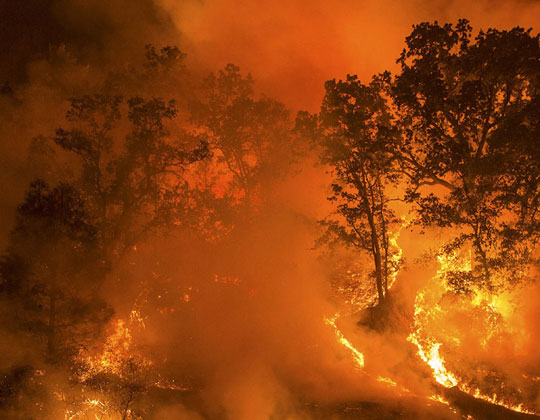Below are summaries from the National Significant Wildland Fire Potential Outlook, provided by the National Interagency Fire Center, for the period of September through December 2022. Additionally, the full wildfire outlook can be located here.
Year-to-Date Statistics:
| Year-to-date statistics | Number of Fires | Acreage Burned |
| 2022 (01/01/22 – 09/01/22) | 48,331 | 6,153,171 |
| 10-year Average (2012-2021) | 40,783 | 5,391,685 |
| Percentage of 10-year Average | 119% | 114% |
Source: https://www.nifc.gov/fireInfo/nfn.htm
Observations in August:
Fire activity continued across much of Texas and Oklahoma through mid-August. However, by the latter half of the month, heavy rainfall caused a rapid decrease in activity. Large fires emerged across California, Oregon, Washington, Idaho, and Montana and continued to burn at the end of the month. Year-to-date acres burned for the US is approximately 114% of the 10-year average. However, over half of the total acres burned in Alaska alone.
Fire activity continued across Texas and Oklahoma through mid-August before rapidly decreasing in the second half of the month due to heavy rainfall, especially across Texas. Significant fire activity continued to slowly increase across the West into mid-August, before remaining steady through the end of the month. Large fires were active across California, Oregon, Washington, Idaho, and Montana at the end of August.

US Drought Monitor Status as of August 30, 2022
US Drought Status
Drought rapidly intensified and expanded across portions of the Northeast due to very dry conditions in August, with southern New England in severe to extreme drought. Drought improvement was noted in Utah, Colorado, New Mexico, and Arizona due to the North American Monsoon. Improvement or removal of drought also occurred in portions of Carolinas, east Texas, and the Lower Mississippi Valley. However, much of California, the Great Basin, Oregon, and central Montana remained in drought.
Drought continues across more than two-thirds of the West and much of the central and southern Plains into the Ozarks. Portions of the Great Basin, California, southeast Oregon, and central and southern Plains remain in extreme to exceptional drought. Drought developed and intensified across portions of the Northeast, with severe to extreme drought in southern New England. Drought was removed in the coastal Carolinas, with significant improvement or removal of drought in Arizona, east Texas, and the Lower Mississippi Valley due to significant rainfall in August.
Wildfire Outlook for September – December:
The monsoon will continue to wane during the first half of September across the Southwest. Above normal precipitation is likely for portions of Arizona, as well as the Gulf Coast. Additionally, the Climate Prediction Center (CPC) forecasts above normal temperatures across the West and Northeast in September, expanding across much of the country for the fall. Below normal precipitation is likely for the fall across much of the US from the Great Basin eastward into the Appalachians, with small areas of above normal precipitation forecast for portions of Florida and Washington. Drought improvement is anticipated across much of the Southwest into the southern Plains, mainly due to anticipated rain through mid-September before drier conditions prevail.
Above normal significant fire potential is forecast for much of the Northeast from September through November due to ongoing drought. Above normal potential is also forecast for much of Oklahoma in September and October, expanding to include all of Oklahoma and Texas by December. The remainder of the Eastern and Southern Areas will likely experience normal fire potential, as well as the Southwest and Rocky Mountain Areas through December. Most of northern California, central and southwest Oregon, southeast Washington, Idaho, and far western Montana will have above normal potential in September.
Most of these areas will return to normal potential in October except across portions of northern California prone to offshore winds. Northern California will return to normal potential for November and December. Finally, the Transverse and Peninsular Ranges of southern California to the coast, areas prone to Santa Ana winds, will have above normal potential from October through December.

September 2022 NIFC Predictive Services Fire Potential Outlook

October 2022 NIFC Predictive Services Fire Potential Outlook

November 2022 NIFC Predictive Services Fire Potential Outlook

December 2022 NIFC Predictive Services Fire Potential Outlook
Source: NIFC




